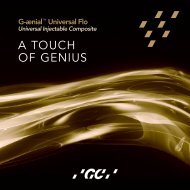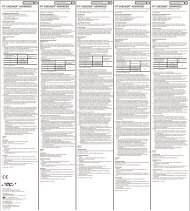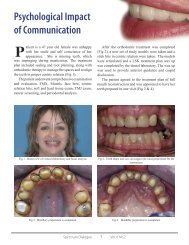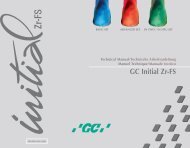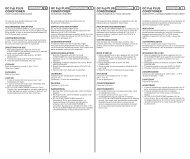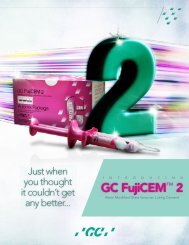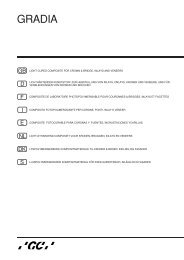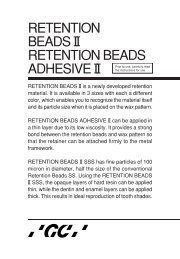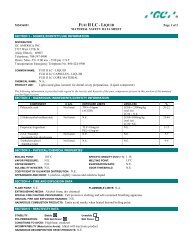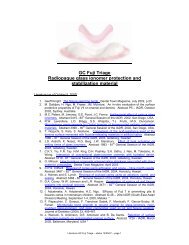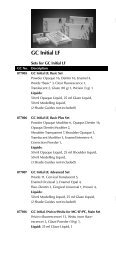Frequently Asked Questions - GC America
Frequently Asked Questions - GC America
Frequently Asked Questions - GC America
Create successful ePaper yourself
Turn your PDF publications into a flip-book with our unique Google optimized e-Paper software.
<strong>Frequently</strong> <strong>Asked</strong> <strong>Questions</strong>
<strong>GC</strong> INITIAL MC<br />
<strong>Frequently</strong> <strong>Asked</strong> <strong>Questions</strong><br />
I have cracks in my metal-porcelain after I steam-cleaned the structure. What went wrong?<br />
There are several po poss s ibilities:<br />
• Incorr rrec ect de desi sign gn oof<br />
th the frame struct ctur u e (sharp edges of metal-frame, e, unequ qual thicknesses es of<br />
po porc rcel elai a n, con o nectors be between different el e ements of bridge too small ll).<br />
• Incorrect preparation of the he aalloy<br />
oy (overhe heatin ing of alloy, wrong burs, pollutio ion of aalloy).<br />
• Cooling or non-cooling stage acc ccor ording to th the Coeffi cient of Thermal Expansion on ( (CT C E) of the<br />
me meta tal has not been respected.<br />
• Cerami mics cs are under-fi red and ceramics whic ich have ve bee e n under-fi red have a different CTE and<br />
there is a bui uild ld up of stress in the ceramics. Thi his st s ress s is released by means of cracks when the<br />
structure is put und nder e an extreme temperature cond n itio ion. n<br />
Solution: increase fi rin ing te t mperatures until the desir ired ed eff ffect is achieved.<br />
What is the CTE value on which <strong>GC</strong> Initial MC/LF can be fi red?<br />
With <strong>GC</strong> Initia ial MC/LF we are able to fi re on aall<br />
ll dden<br />
enta tal alloys with a CTE between 13 13,8 , and 14,9<br />
(25°C - 500° 0°C).<br />
Non-precious alloys: Why must the firing temperature of the first opaque fi ring (wash brand) by<br />
non-precious alloys be increased by 20°C?<br />
Non-precious us all lloys are poor heat cond nduc u tors. The temperature must be increa ease sed by 20°C to enable<br />
good physical properties and correct bondi ding ng to be achieved.<br />
Can I re-wet the powder opaques of <strong>GC</strong> Initial MC? Which liquid can we use for this?<br />
MC-powder opaques can be re-wet when dry with normal dis isti till lled e wat ater er.<br />
Should the new powder opaques of <strong>GC</strong> Initial MC also be fi red 20°C higher on non-precious mmetals?<br />
s?<br />
Yes, as non-precious metals are poor heat-conductors, they should also be fi red at 20° 0°C higher<br />
temperature.<br />
What should a good fi rst paste-opaque look like after being fi red?<br />
Shiny.<br />
Can I di dilu lute t the <strong>GC</strong> Initial MC paste opaques?<br />
Yes, this can be done using the new <strong>GC</strong> Initial MC paste opaque thinner. An important rule with this<br />
liquid is to avoid using too much. Put a drop of the past opaque thinner aside and simply pass the<br />
top of a brush through it. Then mix the paste opaque using the opaque brush until you get a nice<br />
homogeneous cons nsistency.<br />
The more the paste opaque is diluted, the longer the pre-drying and drying stages have to be<br />
programmed - up to 8-10 minutes pre-drying is needed to avoid cracks.
Paste opaque : After fi ring, there are air bubbles in the opaque uer. What went wrong?<br />
Make sure that no water is mixed with the opaquer. r. Dry Dryin<br />
ing time, pre-heating ti time and heating rate<br />
(80°/min) must be respected. Otherwise the opa paqu quer, which contains glyce cerine, will boil. Make sure<br />
that the alloy is not contaminated. Zn-con onta tain inin ing alloys can also have problems. p The treatment of the<br />
surface of those Zn-containing alloy oys is vvery<br />
important. Carefully ly follow f the alloy manufacturer’s IFU.<br />
What is the purpose of an oxidation fi ring?<br />
To create a chemic ical al bond between the meta tal and opaque by means of oxygen ions. An oxidati tion is<br />
also a good vi visu sual control to see if the<br />
alloy is clean. The alloy is well-prepared and clean if there are<br />
no spots ts on the alloy af afte ter th the oxidation firing.<br />
How do you do a proper oxi xida dati tion on?<br />
Refe fer to the all alloy<br />
oy manufacturer’s instructions.<br />
Can we use <strong>GC</strong> Initial MC on a refractory die model?<br />
Yes, <strong>GC</strong> Initial MC can be used on a refractory die model. Just increase the fi ring temperatures of the<br />
build up powders by 20°C.<br />
Using <strong>GC</strong> Initial MC when making veneers or inlays on a refractory die model, do I have to increase the<br />
fi ring temperatures?<br />
We advise increasing all temperatures by 20°C because the refractory die absorbs heat.<br />
Is there a way to fi x the colors internally in the ceramics?<br />
Yes, this can be done by customizing the fi red body with the stains (mixed with stain liquid) and fi xing<br />
these colors using a glaze fi ring at a temperature that is 50°C below that of the fi rst dentine fi ring of<br />
<strong>GC</strong> Initial MC. Afterward the crown can be fi nished using a normal dentine fi ring over these colors<br />
with, for example, <strong>GC</strong> Initial CL-F.<br />
Can I make a correction to <strong>GC</strong> Initial MC using <strong>GC</strong> Initial LF?<br />
There is no problem using this method as the CTE´s of both ceramic lines are perfectly compatible.<br />
When the surface of the <strong>GC</strong> Initial LF needs to be glazed, use the <strong>GC</strong> Initial INvivo/INsitu stains for<br />
MC/LF and use a glaze-fi ring program for <strong>GC</strong> Initial Low Fusing. Take into consideration that the <strong>GC</strong><br />
Initial MC will not be glazed at the LF glaze temperature!<br />
<strong>GC</strong> INITIAL LF<br />
<strong>Frequently</strong> <strong>Asked</strong> <strong>Questions</strong><br />
To avoid discoloration with <strong>GC</strong> Initial LF, is there a limitation in percent Ag for alloys?<br />
Use of certain alloys which contain more than 5 percent Ag could lead to discoloration, although<br />
this is not the general rule. This has nothing to do with the <strong>GC</strong> Initial ceramic, as such, but is more a<br />
general rule for all LF ceramics. Certain Ag-containing alloys show no discoloration even with a higher<br />
percentage of silver.
<strong>Frequently</strong> <strong>Asked</strong> <strong>Questions</strong><br />
Is it possible to fire <strong>GC</strong> Initial LF ceramics on <strong>GC</strong> Initial MC paste opaque?<br />
Yes, there are no pr p oblems concerning the co c mpatibility.<br />
Can I make a correction with <strong>GC</strong> Initial LF on <strong>GC</strong> Initial MC?<br />
There is no proble lem using this method, as the CTE’ E’s of both ceramic lines are perfectly compatible.<br />
When the surface of the <strong>GC</strong> Initial LF needs to be glazed ed, use the <strong>GC</strong> Initial INvivo/INsitu stains. For<br />
<strong>GC</strong> Initial MC/LF and use a glaze-fi ring program for <strong>GC</strong> Ini niti tial Low Fusing. Take into consideration the<br />
fact that the <strong>GC</strong> Initial MC will not be glazed at the <strong>GC</strong> Initial LF glaze temperature!<br />
Non-precious alloys: Why must the fi ring temperature of the <strong>GC</strong> Initial LF fi rst opaque (wash brand) on<br />
no nonn<br />
precious alloys be inc ncreased by 20°C?<br />
Non-precious all lloy oys are poor heat conductors. The temperature must be increa eased by 20°C to enable<br />
good physical properti ties es aand<br />
correct bonding.<br />
What sho houl uld th thefi rst powder-opaqu que look like af afte ter being fi red?<br />
Shiny.<br />
What is the use of an oxidation fi ring?<br />
To create a chemical bond between the me meta tal and opaque by me mean ans of oxy oxygen<br />
ions. Oxidation is<br />
also a good visual control to see if the alloy is clea ean. n. The alloy is well-prepared an a d clean if there are<br />
no spots on the alloy after the oxidation fi ring.<br />
How do you do a proper oxidation?<br />
Refer to the alloy manufacturer’s instructions.<br />
Is it possible to use <strong>GC</strong> Initial LF to build up on Ivoclar “Empress 1 or 2?”<br />
No, because the CTE of these press ingots is +/- 17, whi hich is too high for the <strong>GC</strong> Initial LF (11.6). The<br />
<strong>GC</strong> Initial PC press ingots are per erfectly adapted to be used in with <strong>GC</strong> Initial LF. On the othe her hand,<br />
the <strong>GC</strong> PressINvest is ideal for pressing the Ivoclar Empress ingots.<br />
Can I use <strong>GC</strong> Initial LF on a refractory die model?<br />
Yes, <strong>GC</strong> Initial can be used on a refractory die mo m del. The fi ring temperatures must be increased by<br />
20°C.<br />
When making veneers or inlays on a refractory die model when using <strong>GC</strong> Initial LF, do I have to increase the<br />
fi ring temperatures?<br />
We advise increasing all temperatures by 20°C, as the re refr f actory die abs bsor o bs heat.<br />
Why is the start temperature on <strong>GC</strong> Initial LF lower than on <strong>GC</strong> Initial MC?<br />
Because the glass transformation point is lower on <strong>GC</strong> In Init itial LF LF. If yyou<br />
were to sta tart rt at a hi high gher<br />
temperature, the ceramic structure would ld already dy hhave<br />
ch chan ange ged be befo fore the vacuu uum starts.
<strong>GC</strong> INITIAL TI<br />
At which temperature is the negative Alpha layer cre reated on Titanium?<br />
The Alpha layer on <strong>GC</strong> Initial Ti is created at aapproximately<br />
840°C. Al All of the <strong>GC</strong> Initial Ti fi ring<br />
temperatures are below this temperat atur ure so there should not be a problem.<br />
On what kind of titanium can <strong>GC</strong> Initial Ti be fi red?<br />
<strong>GC</strong> Initial Ti can be fifir<br />
red d on pure milled titani nium um, cast titanium and titanium alloys.<br />
Is it possible to re-wet the G<strong>GC</strong><br />
In Init itial Ti-bonder powder with the sp special li liqu quid id?<br />
No, once dried ed, you must prepare new Ti-bonding.<br />
How does a good first opaque look?<br />
Sh Shiny.<br />
Is it possible to re-wet the Titanium powder opaque when it is too dry?<br />
Dry titanium-powder opaque mixture can only be re-wet with distilled water. You should not<br />
re-wet the opaque repeatedly as this will change the modeling qualities of the opaque.<br />
Do you need to do an oxidation on Titan?<br />
No, because you should avoid any heat treatment that is not necessary.<br />
How should the <strong>GC</strong> Initial Ti-bonder look after being fi red on a Ti-coping?<br />
The Ti-bonder should look shiny/glossy on a black Titanium coping.<br />
According to <strong>GC</strong> Initial Ti ‘s technical manual, sandblasting with “noble corundum” must be done before<br />
the <strong>GC</strong> Initial Ti bonder application. Can we also use Aluminum Oxide?<br />
Yes, you can, as long as you are only using new, pure abrasive sandblasting material of 120 to 150m,<br />
as mentioned in the technical manual. Do not use sandblasting material that has already been used.<br />
<strong>GC</strong> INITIAL AL<br />
<strong>Frequently</strong> <strong>Asked</strong> <strong>Questions</strong><br />
With which kind of ceramic do I have to work on Spinell?<br />
We recommend using <strong>GC</strong> Initial AL porcelain, as the CTE of Spinell is ca. 7,7 (20-500°C).<br />
What might be the reason for cracks in a glass infi ltrated <strong>GC</strong> Initial AL-coping?<br />
One of the main reasons might be that there is still excessive glass in the glass infi ltrate <strong>GC</strong> Initial<br />
AL copings. Normally glass is removed by doing several glass control fi rings. After the control fi ring,<br />
the excess glass comes to the surface and must be sandblasted. Repeat control fi rings until no more<br />
glass comes to the surface of the coping.
<strong>Frequently</strong> <strong>Asked</strong> <strong>Questions</strong><br />
Why aren’t there shade guide tabs for <strong>GC</strong> Initial AL liners on the shade guide?<br />
<strong>GC</strong> Initial AL liners (6 shades) are not included on the shade guide because they are only used as a<br />
wash bake on the frame structure. This layer is too thin to be compared, color wise, with the shade<br />
pellet on the shade guide, which is +/- 1 mm thick. This means that the shade on the shade guide<br />
cannot correspond to the much thinner wash bake layer. If a more intense color is required, the liners<br />
can be mixed with the fl uorescent <strong>GC</strong> Initial INvivo stains.<br />
With which liquid can we re-wet the dried <strong>GC</strong> Initial AL-porcelain?<br />
You can only re-wet the dried AL porcelain by using distilled water.<br />
With which liquid can I mix the <strong>GC</strong> Initial AL liner?<br />
You must mix the <strong>GC</strong> Initial AL liners with the normal <strong>GC</strong> Initial AL modeling liquid. When re-wetting<br />
the dried AL liners, only use distilled water.<br />
<strong>GC</strong> INITIAL ZR<br />
Is it possible to use <strong>GC</strong> Initial Zr for Cercon system from Dequedent?<br />
Yes, Cercon is also a Zirconium oxide ceramic frame material. <strong>GC</strong> Initial Zr can be used for the<br />
layering technique on this system to achieve highly esthetic results.<br />
Metal ceramics: If I fi re 6-8 times, I get cracks in the ceramics. Do you have that problem with<br />
<strong>GC</strong> Initial Zr?<br />
It is not so much an issue of which base structure you are working on, but more the ceramic itself and<br />
in particular the leucite content of these ceramics. Leucite is the component that changes the CTE.<br />
After multiple fi rings, the CTE will become higher and, at a certain point, no longer be compatible<br />
with the metal frame. Logically, it will happen more with alloys with a lower CTE. This multiple fi ring<br />
is not as sensitive for Zr structures is because <strong>GC</strong> Initial Zr does not contain any leucite. Therefore,<br />
ythere are no changes in the CTE and no cracking. Because the Zr coping is a poor heat conductor<br />
compared to metal, you must be careful about cooling time.<br />
With which liquid can we mix <strong>GC</strong> Initial Zr frame modifi ers?<br />
You must mix the frame modifi ers with the normal Zr modeling liquid. When re-wetting the dried<br />
frame modifi ers, only use distilled water.<br />
If the frame modifi er does not cover the <strong>GC</strong> Initial Zr frame structure well after the fi rst fi ring, can I fi re<br />
the frame modifi er a second time and at what temperature?<br />
Yes, you can fi re the frame modifi ers several times in order to cover the frame, by always fi ring the<br />
frame modifi ers at the same temperature. In other words, starting temperature of 450°C, 4 minutes<br />
preheating, increase the temperature 55°C, vacuum yes, fi nal temperature of 800°C, holding time 1<br />
minute. The appearance of the frame modifi er should be slightly glossy. To intensify the <strong>GC</strong> Initial Zr<br />
frame modifi ers, fl uorescent <strong>GC</strong> Initial INvivo stains can be mixed with the <strong>GC</strong> Initial Zr frame modifi ers.
<strong>Frequently</strong> <strong>Asked</strong> <strong>Questions</strong><br />
<strong>GC</strong> Initial Zr shoulder ceramic needs a higher fi ring temperature than the Zr frame modifi er. Is that correct?<br />
Yes, in-house tests have shown that 830°C gives optimal fi ring results for the <strong>GC</strong> Initial Zr shoulder<br />
porcelain, <strong>GC</strong> Initial Zr frame modifi ers are fi red at 800°C . Because of this, shoulder fi rings should be<br />
done before frame modifi er fi ring.<br />
Why aren’t there shade guide tabs for <strong>GC</strong> Initial Zr frame modifi er on the <strong>GC</strong> Initial Zr shade guide?<br />
<strong>GC</strong> Initial Zr frame modifi ers (3 shades) are not included on the shade guide because they are only<br />
used as a wash bake on the frame structure. This layer is too thin to be compared, color wise, with the<br />
shade pellet on the shade guide, which is +/- 1 mm thick. This means that the shade on the shade<br />
guide cannot correspond to the much thinner wash bake layer.<br />
Can you modify and customize a Zirconium cap before applying the frame modifi er on the cap?<br />
You cannot stain directly onto the Zirconium-cap. There are, however, two methods to modify the<br />
frame modifi er. This can be done by fi ring the <strong>GC</strong> Initial INvivo/INsitu stains mixed with stain liquid on<br />
top of the already-fi red frame modifi er using a fi ring temperature of 800°C. Another way is by mixing<br />
pure <strong>GC</strong> Initial INvivo/INsitu powders (no stain liquid) under the frame modifi er using the normal <strong>GC</strong><br />
Initial Zr modeling liquid.<br />
Creation Zi has a higher liner fi ring temperature (900°C) compared to <strong>GC</strong> Initial Zr (800°C). It has also<br />
been reported that Creation Zi has a higher bonding strength (Teamwork Special, 1/2004, pg. 56).<br />
Is this correct?<br />
No, this is not correct. The reason for the higher temperature is that Creation Zi liner is based on the<br />
Creation In Nova stains, which require such a high fi ring temperature. The bonding of the Creation<br />
Zi liner to the Zr frame structure is surely not higher than the bonding strength of <strong>GC</strong> Initial frame<br />
modifi ers. <strong>GC</strong> Initial Zr frame modifi ers are much weaker in color, but can be intensifi ed by using <strong>GC</strong><br />
Initial INvivo/INsitu, offering a wider range of possibilities compared to Creation Zr.<br />
<strong>GC</strong> INITIAL PC<br />
What is the ideal thickness of a ceramic pressed facing?<br />
The ideal thickness, to avoid deformation, is 0,8 mm. If the coping is thinner and the layer of <strong>GC</strong><br />
Initial LF is too thick, there will be a deformation at the margins. The thickness of a pressed facing can<br />
be from 0,5 mm to 1,5 mm in the incisal area.<br />
Is it possible to make full ceramic bridges when using the <strong>GC</strong> Initial PC press pellets?<br />
No, we recommend making only single units including molars. However, an injection of PC ceramics<br />
on a supporting 3-unit metal frame is not a problem. Note that the metal frame should be opaqued.<br />
How long does a <strong>GC</strong> Initial PC invest cylinder have to be in the pre-heated furnace before injecting<br />
ceramics?<br />
60 minutes at 850°C.For each additional cylinder the holding time should be extended by 10 minutes.
<strong>Frequently</strong> <strong>Asked</strong> <strong>Questions</strong><br />
How do the <strong>GC</strong> Initial PC crowns have to be positioned on the base former?<br />
The wax sprues on the wax crowns should be ca .5-.6 mm in length (3,0 - 3,5 mm diameter) and<br />
should be positioned on the small cylinder from the ring base former. The wax crowns should be<br />
positioned apart and at an angle of 45° away from the thermal centre with a distance between the<br />
individual objects of at least 3mm.<br />
What is the ideal layering for a <strong>GC</strong> Initial PC crown?<br />
When using the layering technique, the ideal amount of <strong>GC</strong> Initial PC ceramics should be more than<br />
2/3 of the total crown. There should be less than 1/3 of <strong>GC</strong> Initial LF fi red on the <strong>GC</strong> Initial PC base.<br />
How much pressure (bar) do you need to produce a good pressed coping? (For Press furnaces ; EP 500,<br />
Touch Press, Shenpaz Press,...)<br />
The minimum pressure is 4,5 bar. Ideally 5 bar. However, the Touch and Press, where a maximum<br />
pressure of only 2,8 bar can be reached, also provides good results.<br />
How can I choose the press pellets for the staining technique?<br />
The choice of press pellets for staining technique is determined by the desired color and by the desired degree<br />
of opacity. First choose the desired degree of opacity depending on the indication. Then determine<br />
the color choice of press pellet by the desired V-shade; yellowish and reddish are more appropriate<br />
for Vita Z and B shades; greyish more for C-shades. Try to choose a press pellet that matches the<br />
color of the incisal zone of the natural teeth as the body of the facing or inlay will be stained with the<br />
INover’s to get the correct V-shade.<br />
<strong>GC</strong> INITIAL INVIVO/INSITU MC/F/PC<br />
Can I use the <strong>GC</strong> Initial INvivo/INsitu MC/LF/PC stains internally when using the <strong>GC</strong> Initial MC powders?<br />
Yes, the <strong>GC</strong> Initial INvivo/INsitu MC/LF/PC stains can be used internally with MC powders in one of<br />
two ways:<br />
1.<br />
2.<br />
Use the <strong>GC</strong> Initial INvivo/INsitu stains internally by mixing pure <strong>GC</strong> Initial INvivo/INsitu stains<br />
under the normal <strong>GC</strong> Initial MC powders using the normal <strong>GC</strong> Initial MC modeling liquid, then<br />
fi ring with a normal dentine fi ring program.<br />
Use the stains ready-mixed with stain liquid and characterize internally the <strong>GC</strong> Initial MC powders<br />
also using a normal dentine-fi ring. When using the stains pre-mixed with the stain liquid, be sure<br />
to have a longer drying stage than normal dentine fi ring and make sure that you do not use too<br />
much stain-liquid.
<strong>Frequently</strong> <strong>Asked</strong> <strong>Questions</strong><br />
Is it possible to use the two <strong>GC</strong> Initial INvivo/INsitu kits for all ceramic systems?<br />
There are two <strong>GC</strong> Initial INvivo/INsitu sets in the <strong>GC</strong> Initial ceramic line available: <strong>GC</strong> Initial INvivo/<br />
INsitu for AL, Zr, Ti and another for the ceramic group MC, LF, PC. The two systems are grouped<br />
according to the CTE of the referenced ceramic line.<br />
1. <strong>GC</strong> Initial INvivo/INsitu for AL, Zr and Ti: used for <strong>GC</strong> Initial AL-aluminum oxide, <strong>GC</strong> Initial Xr -<br />
Zirconium oxide, <strong>GC</strong> Initial Ti - Titanium restorations.<br />
2. <strong>GC</strong> Initial INvivo/INsitu for MC, LF and PC: used for <strong>GC</strong> Initial MC-metal ceramic, <strong>GC</strong> Initial LF -<br />
low fusing ceramic, <strong>GC</strong> Initial PC - pressable ceramic.<br />
Is it possible to use <strong>GC</strong> Initial INvivo/INsitu for internal and for external characterizations at the same time?<br />
<strong>GC</strong> Initial INvivo/INsitu is used for natural, individual staining and characterization of <strong>GC</strong> Initial<br />
ceramic line. <strong>GC</strong> Initial INvivo: fl uorescent shades for internal and external characterization. <strong>GC</strong> Initial<br />
INsitu: fl uorescent shades only for external characterization.<br />
INVIVO/INSITU AL/ZR/TI<br />
Is it possible to use the two <strong>GC</strong> Initial INvivo/INsitu kits for all ceramic systems?<br />
There are two INvivo/INsitu sets in the <strong>GC</strong> Initial ceramic line available: <strong>GC</strong> Initial INvivo/INsitu for AL,<br />
Zr, Ti and another for the ceramic group MC, LF, PC. The 2 systems are grouped according to the CTE<br />
of the referenced ceramic line.<br />
1. <strong>GC</strong> Initial INvivo/INsitu for AL, Zr and Ti: used for <strong>GC</strong> Initial AL-aluminum oxide, <strong>GC</strong> Initial Xr -<br />
Zirconium oxide, <strong>GC</strong> Initial Ti - Titanium restorations.<br />
2. <strong>GC</strong> Initial INvivo/INsitu for MC, LF and PC: used for <strong>GC</strong> Initial MC-metal ceramic, <strong>GC</strong> Initial LF -<br />
low fusing ceramic, <strong>GC</strong> Initial PC - pressable ceramic.<br />
<strong>GC</strong> INITIAL CERAMIC LINE<br />
Do all <strong>GC</strong> Initial ceramic powders contain fl uo-particles?<br />
Nearly all powders contain fl uo-particles except the opaques and the three <strong>GC</strong> Initial Insitu’s, that<br />
have been developed to create certain opacious effects. All other <strong>GC</strong> Initial powders contain fl uo<br />
particles but certain powders contain more fl uo than others. The amount of fl uo depends on the color<br />
and the opacity of the ceramic.<br />
What might be the reason for bubbles in the opaque on non-precious metals?<br />
• Pollution of metal by using incorrect burs or by using burs which have been used for other<br />
metals.<br />
• Bad condition of metal structure (e.g. Porosities caused by a too-high casting temperature,<br />
hollow spaces in frame structure due to overlapping of metal during fi nishing of frame structure).<br />
• Opaque dried incorrectly (drying time too short).<br />
• First opaque applied too thick.<br />
•<br />
Rate of increase of temperature per minute too high.
<strong>Frequently</strong> <strong>Asked</strong> <strong>Questions</strong><br />
How do I know the exact fi ring temperature in the porcelain furnace?<br />
Before you start, it is important to calibrate your furnace, to ensure that the temperature on the<br />
display is the same as in the fi ring chamber.<br />
Enamel cracks : What might be the reason for cracking of the enamel fi ring on top of the dentine base?<br />
Either the enamel porcelain powder of another porcelain system has been mistakenly taken, or the<br />
dentin porcelain mixture has been built up too dryly when enamel has been applied.<br />
Most manufacturers of non-precious metals prescribe use of a long cooling stage when fi ring ceramics. Do<br />
I have to follow this as an <strong>GC</strong> Initial user?<br />
For <strong>GC</strong> Initial MC and LF we must follow the instructions from the alloy manufacturers even when the<br />
CTE of the alloy is very low and normally is not necessary for our ceramics.<br />
Is it necessary to trim the ceramic surface between the fi rings?<br />
No, but it improves bonding, especially when large amounts of material are needed for the next layer.<br />
May we re-mix the porcelain mixtures on the glass plate with <strong>GC</strong> Initial liquids?<br />
New, fresh porcelain powder must be mixed with <strong>GC</strong> Initial liquids. When these mixtures are dried<br />
out they may only be re-wetted with distilled water.<br />
Can you exchange modelling liquids from the different <strong>GC</strong> Initial components?<br />
No, basically they contain more or less the same chemicals but are different in ratios, besides the fact<br />
that the <strong>GC</strong> Initial MC liquids would not burn completely with <strong>GC</strong> Initial LF.<br />
Do we have to rewet the refractory die before fi ring ceramics on it?<br />
Yes, this can be done by putting the refractory die a glass of water for 1 minute. In this way the<br />
refractory die has the same humidity as the ceramic and this avoids the soaking up of the ceramic<br />
modelling liquid by the refractory material. In this way it is easier to apply the ceramics onto the<br />
refractory die.<br />
What is the use of the connector paste?<br />
The connector paste has been developed in order to work more easily on a refractory die model. It<br />
will be the fi rst layer of porcelain on the refractory die so the fi t on the die of the inlay or facing will be<br />
perfect. The connector paste has also been developed in order to avoid the drying out of the ceramic<br />
mixtures on the refractory die during building up.<br />
Is one layer connector paste suffi cient to start fi ring on a refractory die?<br />
Normally the refractory die should look nice and shiny because of connector paste. If not after one<br />
layer connector paste, a second layer connector paste can be applied and fi red until the desired shiny<br />
effect is obtained.
<strong>GC</strong> Initial MC - for Standard Metal Build-Ups<br />
<strong>GC</strong> Initial LF - for Low Fusing Technique<br />
<strong>GC</strong> Initial Ti - for Titanium Build-Ups<br />
<strong>GC</strong> Initial Al - for Aluminum Oxide Framework<br />
<strong>GC</strong> Initial Zr - for Zirconium Oxide Framework<br />
<strong>GC</strong> Initial PC - Pressed Ceramic Technique<br />
<strong>Frequently</strong> <strong>Asked</strong> <strong>Questions</strong><br />
What is the use of the INcisio?<br />
INcisio is a violet coloured stain that can be used as a ceramic powder mixed with modelling liquid to<br />
create internally an effect of depth. It can be applied in the incissal zone between the mamelons to<br />
create this effect. The INcisio can also be used as a pure stain mixed with stain liquid to create also an<br />
effect of depth but is than stained on the surface.<br />
Can the type of fi ring tray infl uence the porcelain?<br />
Yes, some heavy body fi ring trays will take up much heat and this will decrease the temperature in<br />
the fi ring chamber. As a result of this the ceramic can be under fi red. On the other hand light trays<br />
will soak up much less heat. As a result of this we recommend you to do the silver-calibration of the<br />
furnace on the fi ring tray that is used for the daily work.<br />
800.323.7063<br />
www.gcamerica.com<br />
www.gcamerica.com/training<br />
© 2011 <strong>GC</strong> <strong>America</strong> Inc.



